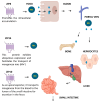The Manganese-Bone Connection: Investigating the Role of Manganese in Bone Health
- PMID: 39200820
- PMCID: PMC11355939
- DOI: 10.3390/jcm13164679
The Manganese-Bone Connection: Investigating the Role of Manganese in Bone Health
Abstract
The complex relationship between trace elements and skeletal health has received increasing attention in the scientific community. Among these minerals, manganese (Mn) has emerged as a key element affecting bone metabolism and integrity. This review examines the multifaceted role of Mn in bone health, including its effects on bone regeneration, mineralization, and overall skeletal strength. This review article is based on a synthesis of experimental models, epidemiologic studies, and clinical trials of the mechanisms of the effect of Mn on bone metabolism. Current research data show that Mn is actively involved in the processes of bone remodeling by modulating the activity of osteoblasts and osteoclasts, as well as the main cells that regulate bone formation and resorption. Mn ions have a profound effect on bone mineralization and density by intricately regulating signaling pathways and enzymatic reactions in these cells. Additionally, Mn superoxide dismutase (MnSOD), located in bone mitochondria, plays a crucial role in osteoclast differentiation and function, protecting osteoclasts from oxidative damage. Understanding the nuances of Mn's interaction with bone is essential for optimizing bone strategies, potentially preventing and managing skeletal diseases. Key findings include the stimulation of osteoblast proliferation and differentiation, the inhibition of osteoclastogenesis, and the preservation of bone mass through the RANK/RANKL/OPG pathway. These results underscore the importance of Mn in maintaining bone health and highlight the need for further research into its therapeutic potential.
Keywords: bone; bone health; bone mass; bone metabolism; manganese.
Conflict of interest statement
The authors have no conflicts of interest.
Figures





Similar articles
-
Aging increases stromal/osteoblastic cell-induced osteoclastogenesis and alters the osteoclast precursor pool in the mouse.J Bone Miner Res. 2005 Sep;20(9):1659-68. doi: 10.1359/JBMR.050503. Epub 2005 May 2. J Bone Miner Res. 2005. PMID: 16059637
-
The Role Of BMPs in the Regulation of Osteoclasts Resorption and Bone Remodeling: From Experimental Models to Clinical Applications.Front Immunol. 2022 Apr 26;13:869422. doi: 10.3389/fimmu.2022.869422. eCollection 2022. Front Immunol. 2022. PMID: 35558080 Free PMC article. Review.
-
Resolvin E1 Promotes Bone Preservation Under Inflammatory Conditions.Front Immunol. 2018 Jun 12;9:1300. doi: 10.3389/fimmu.2018.01300. eCollection 2018. Front Immunol. 2018. PMID: 29946319 Free PMC article.
-
DOK3 Modulates Bone Remodeling by Negatively Regulating Osteoclastogenesis and Positively Regulating Osteoblastogenesis.J Bone Miner Res. 2017 Nov;32(11):2207-2218. doi: 10.1002/jbmr.3205. Epub 2017 Aug 2. J Bone Miner Res. 2017. PMID: 28650106 Free PMC article.
-
Osteoclast differentiation by RANKL and OPG signaling pathways.J Bone Miner Metab. 2021 Jan;39(1):19-26. doi: 10.1007/s00774-020-01162-6. Epub 2020 Oct 20. J Bone Miner Metab. 2021. PMID: 33079279 Review.
Cited by
-
Bifunctional Metal Ion-Enhanced PDA-Coated Titanium for Superior Osteogenic and Antimicrobial Performance.ACS Appl Bio Mater. 2025 Jul 21;8(7):5568-5579. doi: 10.1021/acsabm.4c01869. Epub 2025 Jun 30. ACS Appl Bio Mater. 2025. PMID: 40589221
-
Evaluating the Carcinogenic and Non-Carcinogenic Health Risks of Heavy Metals Contamination in Drinking Water, Vegetables, and Soil from Gilgit-Baltistan, Pakistan.Toxics. 2024 Dec 25;13(1):5. doi: 10.3390/toxics13010005. Toxics. 2024. PMID: 39853004 Free PMC article.
-
Manganese deficiency or dietary manganese(III) oxide nanoparticle supplementation: consequences for hematology, and intestinal and brain immunity in rats.Front Immunol. 2025 Apr 8;16:1528770. doi: 10.3389/fimmu.2025.1528770. eCollection 2025. Front Immunol. 2025. PMID: 40264758 Free PMC article.
-
Heavy metal pollution in poultry feeds and broiler chickens in Bangladesh.Toxicol Rep. 2025 Jan 26;14:101932. doi: 10.1016/j.toxrep.2025.101932. eCollection 2025 Jun. Toxicol Rep. 2025. PMID: 39968052 Free PMC article.
References
-
- Vanitchanont M., Vallibhakara S.A., Sophonsritsuk A., Vallibhakara O. Effects of Multispecies Probiotic Supplementation on Serum Bone Turnover Markers in Postmenopausal Women with Osteopenia: A Randomized, Double-Blind, Placebo-Controlled Trial. Nutrients. 2024;16:461. doi: 10.3390/nu16030461. - DOI - PMC - PubMed
-
- Lopes T.S.B., Shi H., White D., Araujo I.C.S., Kim W.K. Effects of 25-hydroxycholecalciferol on performance, gut health, and bone quality of broilers fed with reduced calcium and phosphorus diet during Eimeria challenge. Poult. Sci. 2024;103:103267. doi: 10.1016/j.psj.2023.103267. - DOI - PMC - PubMed
Publication types
Grants and funding
LinkOut - more resources
Full Text Sources

